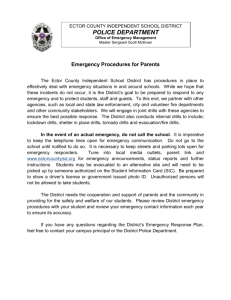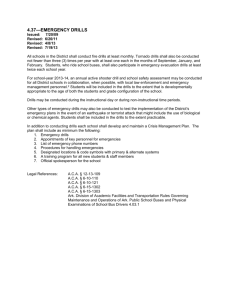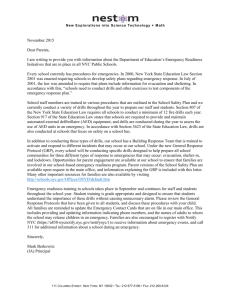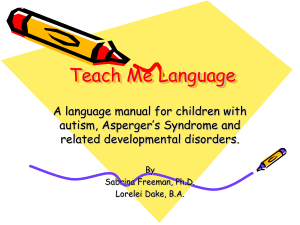For Immediate Release NASP and NASRO Release Guidance on Conducting Active
advertisement
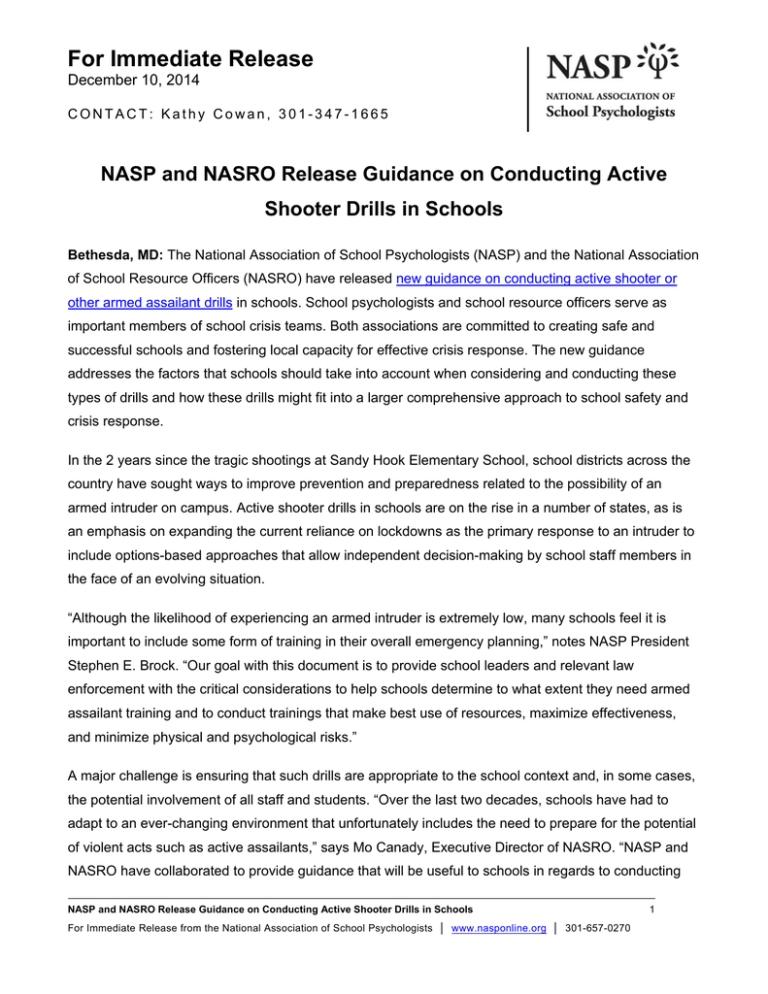
For Immediate Release December 10, 2014 CONTACT: Kathy Cowan, 301-347-1665 NASP and NASRO Release Guidance on Conducting Active Shooter Drills in Schools Bethesda, MD: The National Association of School Psychologists (NASP) and the National Association of School Resource Officers (NASRO) have released new guidance on conducting active shooter or other armed assailant drills in schools. School psychologists and school resource officers serve as important members of school crisis teams. Both associations are committed to creating safe and successful schools and fostering local capacity for effective crisis response. The new guidance addresses the factors that schools should take into account when considering and conducting these types of drills and how these drills might fit into a larger comprehensive approach to school safety and crisis response. In the 2 years since the tragic shootings at Sandy Hook Elementary School, school districts across the country have sought ways to improve prevention and preparedness related to the possibility of an armed intruder on campus. Active shooter drills in schools are on the rise in a number of states, as is an emphasis on expanding the current reliance on lockdowns as the primary response to an intruder to include options-based approaches that allow independent decision-making by school staff members in the face of an evolving situation. “Although the likelihood of experiencing an armed intruder is extremely low, many schools feel it is important to include some form of training in their overall emergency planning,” notes NASP President Stephen E. Brock. “Our goal with this document is to provide school leaders and relevant law enforcement with the critical considerations to help schools determine to what extent they need armed assailant training and to conduct trainings that make best use of resources, maximize effectiveness, and minimize physical and psychological risks.” A major challenge is ensuring that such drills are appropriate to the school context and, in some cases, the potential involvement of all staff and students. “Over the last two decades, schools have had to adapt to an ever-changing environment that unfortunately includes the need to prepare for the potential of violent acts such as active assailants,” says Mo Canady, Executive Director of NASRO. “NASP and NASRO have collaborated to provide guidance that will be useful to schools in regards to conducting NASP and NASRO Release Guidance on Conducting Active Shooter Drills in Schools For Immediate Release from the National Association of School Psychologists │ www.nasponline.org │ 301-657-0270 1 NASP and NASRO Release Guidance on Conducting Active Shooter Drills in Schools armed assailant drills. This collaboration is critical as we strive to find the balance between conducting an effective drill while being attentive to the mental health issues that can emerge as a result of improperly conducted drills.” The guidelines recommend that schools engage in simple discussion-based exercises before considering more intense full-scale simulation drills. If and when such drills are held, schools must consider factors such as developmental maturity, psychological history, prior traumatic experiences, personality, and special needs of participants. All participants should have a chance to opt out and be notified in advance of all planned activities included in the drill. Parental permission should be required for all students. Staff should be trained to recognize common trauma signs and monitor participants during the drill, and all participants should have access to school-employed mental health professionals after the drill’s completion. The document includes a hierarchy of education and training options as well as a review of levels of developmental safety awareness. “The importance of addressing the mental health of students and staff in any crisis planning and response cannot be overstated,” according to Brock. “We rightly focus on physical safety in responding to emergencies, but we also must consider emotional and psychological consequences. Individuals respond differently to stressful situations, and how we handle these factors can either prevent, or contribute to, unnecessary trauma.” Authors also point out that any armed assailant exercises should be considered as only one component of a comprehensive approach to school safety and crisis response. Given resource realities for many schools, training should meet the specific needs of the school and community, and more intensive, fullscale drills should be conducted with careful consideration of the potential costs, risks, and benefits involved. The new guidance seeks to aid schools in coming to an informed decision regarding the best approach for them. Input to the recommendations was also contributed by Safe and Sound: A Sandy Hook Initiative, a nonprofit organization representing families, educators, and other members of the school community, and the ALiCE Training Institute, a for-profit company that provides active shooter training. The document has been endorsed by several national associations in the education community. The document is available at www.nasponline.org/armed-assailant-drills. For further information, see www.nasponline.org and www.nasro.org, or contact Kathy Cowan, NASP Director of Communications, 301-657-0270, ext. 226, or kcowan@naspweb.org. ### NASP and NASRO Release Guidance on Conducting Active Shooter Drills in Schools For Immediate Release from the National Association of School Psychologists │ www.nasponline.org │ 301-657-0270 2


